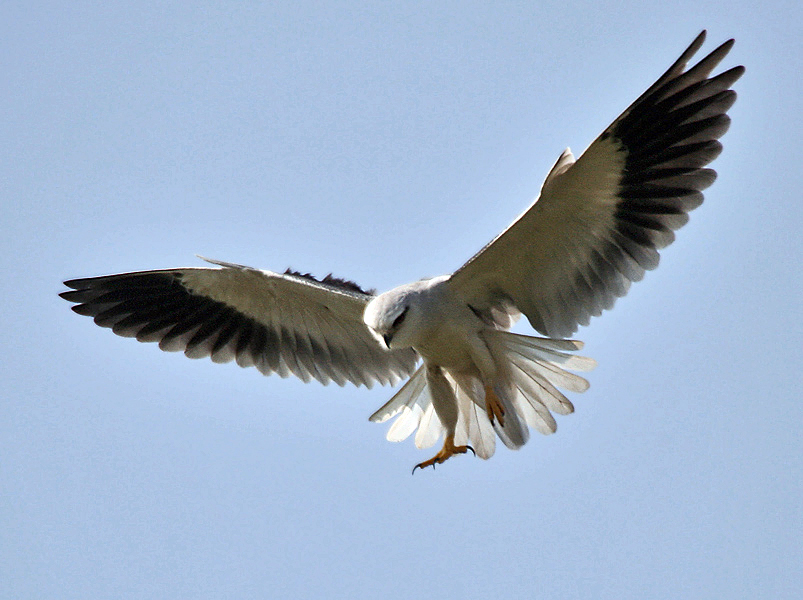
Black-winged Kite
Elanus Caeruleus
Order:
Family:
Size:
32 to 38 centimeters (12.6 to 15 inches)
Weight:
250 to 400 grams (8.8 to 14.1 ounces)
Taxonomy:
(Linnaeus, 1758)
Short Description:
The black-winged kite (Elanus caeruleus), also known as the black-shouldered kite , is a small diurnal bird of prey in the family Accipitridae best known for its habit of hovering over open grasslands in the manner of the much smaller kestrels. This Eurasian and African species was sometimes combined with the Australian black-shouldered kite (Elanus axillaris) and the white-tailed kite (Elanus leucurus) of North and South America which together form a superspecies. This kite is distinctive, with long wings; white, grey and black plumage; and owl-like forward-facing eyes with red irises. The owl-like behaviour is even more pronounced in the letter-winged kite (Elanus scriptus), a nocturnal relative in Australia. Although mainly seen on plains, they are sometimes seen on grassy slopes of hills in the higher elevation regions of Asia. They are not migratory but show nomadism in response to weather and food availability. They are well adapted to utilize periodic upsurges in rodent populations and can raise multiple broods in a single year unlike most birds of prey. Populations in southern Europe have grown in response to human activities, particularly agriculture and livestock rearing.This long-winged raptor is predominantly grey or white with black shoulder patches, wing tips, and eye stripe. The long falcon-like wings extend beyond the tail when the bird is perched. In flight, the short and square tail is visible and it is not forked as in the typical kites of the genus Milvus. When perched, often on roadside wires, it often adjusts its wings and jerks its tail up and down as if to balance itself. The sexes are alike in plumage. Their large forward-facing eyes placed under a bony shelf that shades them is distinctive; their velvety plumage and zygodactyl feet[8] are characters shared with owls and the genus has been considered as a basal group within the Accipitridae. They are thought to have been adapted for living in savanna habitats where seasonal rodent population peaks occur. Such food resources are also favored by the owls. The inner vanes of the feathers have velvety barbules. They have a diploid chromosome number of 68 (some older studies claimed 64 for E.c.caeruleus and 66 for E.c.vociferus) with a distinct karyotype with resemblances to the kites and honey buzzards and suggesting a basal position within the diurnal birds of prey.The black-winged kite breeds at different times of the year across its range. Although nesting has been noted throughout the year in India, they appear not to breed in April and May. Males establish territories and defend them from the competition. Females move into the territories of males. Studies in Africa found that males were more numerous than females. Courtship is noisy and involves chases and once the pair is formed they copulate frequently. The nest is a loose platform of twigs in which 3 or 4 eggs are laid. The female spends more effort in the construction of the nest than the male. The eggs are pale creamy with spots of deep red. Both parents incubate but when the chicks hatch, the male spends more time foraging for food. Very Common in most of the Punjab and Eastern parts of Sind. Resident throughout the indus basin extending into pure deserts .Avoids mountainous areas.
Far far away, behind the word mountains, far from the countries Vokalia and Consonantia, there live the blind texts. Separated they live in Bookmarksgrove right at the coast
Lahore,Bahawalpur,Rahim Yar Khan,Kasur,Vehari,Bahawalnagar,Multan,Attock,Bhakkar,Chakwal,Chiniot,Dera Ghazi Khan,Faisalabad,Gujranwala,Gujrat,Hafizabad,Jhang,Khanewal,Khushab,Mandi Bahauddin,Mianwali,Muzaffargarh,Okara,Rajanpur,Rawalpindi
Black-winged Kite (Elanus caeruleus) demonstrates distinctive behaviors that are vital for its survival in varied habitats. Known for its remarkable hovering hunting technique, the kite gracefully hovers in mid-air, meticulously scanning the ground below for prey. With keen eyesight, it targets small mammals, insects, and occasionally birds, swooping down swiftly to capture its quarry. This avian predator also exhibits territorial behavior, vigorously defending its nesting sites and hunting territories from intruders during the breeding season. The kite constructs its nest in tall trees, bushes, or even on man-made structures, utilizing twigs and grasses
Far far away, behind the word mountains, far from the countries Vokalia and Consonantia, there live the blind texts. Separated they live in Bookmarksgrove right at the coast
About Photographer : Hello World
Facebook
Twitter
Instagram
Flicker
LinkedIn

